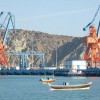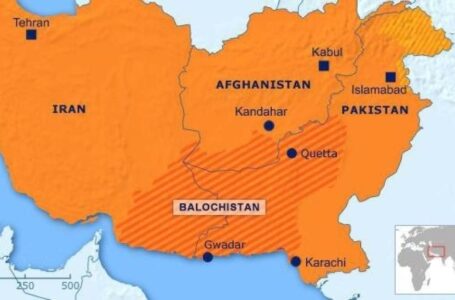The Case for a Free Balochistan: A Catalyst for Regional Stability and Prosperity
Far from plain sailing on the Maritime Silk Road

Author: Sinderpal Singh, RSIS
China’s South Asian ambitions for its Maritime Silk Road (MSR) have hit foul waters. On the one hand, the MSR must navigate the strategic competition between India and China, and on the other it needs to satisfy the divergent interests of Bangladesh, India, the Maldives, Pakistan and Sri Lanka (the South Asian countries on the MSR). Its growth in the region is not likely to be smooth.
Pakistan plays a pivotal role in China’s MSR scheme through the China–Pakistan Economic Corridor (CPEC) — a key Belt and Road Initiative (BRI) project that serves as the crucial link between the maritime ‘road’ and the land-based ‘belt’. The Pakistani port of Gwadar, which is built, financed and operated by China, is located at the confluence of the Gulf of Oman and the Arabian Sea, and it provides China (through Kashgar in its western Xinjiang province) access to a key location in the Indian Ocean.
China has made huge financial commitments to CPEC, which have been largely welcomed by the Pakistani leadership as a means of boosting Pakistan’s economy grounded in their ‘all-weather’ bilateral relationship. But there has recently been growing unease within sections in Pakistan about the long-term benefits of CPEC and about the creeping transferral of sovereignty to China — specifically through Pakistan’s CPEC debt burden.
These are not the only points of concern in the China–Pakistan relationship: China had wanted the renminbi to be used in the Gwadar free-port area, and China seemingly made moves to talk directly to separatist rebels in Pakistan’s restive Balochistan region. Islamabad is increasingly aware of Pakistan’s dependence on its northern neighbour.
Pakistan is not alone in its fears. India views the MSR and China’s broader BRI as a major threat to Indian security and strategic interests. On the soft-power front, New Delhi worries that regional countries’ strategic choices regarding the MSR may be ‘hard-wiring’ these countries into Beijing’s orbit through debt burdens. On the hard-power front, New Delhi fears China aims to deploy Gwadar in the medium to long term as a dual-use port that would allow key access into the Indian Ocean for China’s armed forces — not to mention that Gwadar bolsters Pakistan’s ability to deter any Indian advantage in the naval realm.
India considers China’s MSR projects more broadly to be part of its strategy of challenging Indian primacy in the Indian Ocean. Maintaining this primacy has been a key strategic objective of the Modi government, and the MSR’s potential to enlarge China’s influence in the Indian Ocean is seen as a direct threat to one of India’s core strategic interests.
Further south, Sri Lanka has leveraged growing ties with China against its sometimes difficult relationship with India. Under Sri Lanka’s previous Rajapaksa government, many in India perceived its island neighbour swinging significantly towards China. China made large loans available to Sri Lanka for infrastructural building as part of China’s MSR, of which the most distinctive project was the Hambantota port on Sri Lanka’s southern coast. The 2015 change in government in Sri Lanka signalled a move away from the earlier perceived swing towards China. Despite this, the current government is bound to some extent by its large MSR debt burden. Reeling from this burden, the Sri Lankan government agreed in 2017 to sell a 70 per cent stake in the Hambantota port to a Chinese state-owned enterprise for 99 years.
Bangladesh is struggling to maintain balance in its relationship with China and India. The Bangladesh–China–India–Myanmar (BCIM) Economic Corridor, a transport initiative that began life in 1999, has now stalled largely because of India’s deep trepidations about the BCIM being part of China’s BRI. In this context, Bangladesh has accepted huge Chinese financing in the form of loans and other agreements — the total now stands at around 28 development projects totalling more than US$20 billion.
Mindful of the possible long-term debt to China, Bangladesh has accepted a Japanese bid to build a port at Matarbari while putting on hold Chinese plans to construct a similar container port on Sonadia Island. But this may not be enough: the current Bangladeshi government is still worried that its hedging strategy between India and China could be compromised by its participation in the MSR.
In the Maldives, a change of government has led to a change in its approach towards India–China competition in the region. In 2013, the new government cancelled an earlier privatisation award to an Indian company to develop the Maldives’ international airport. This was followed by an agreement with China to build infrastructure connecting the airport and a port on the atoll of Laamu. China is now deeply involved in the development and expansion of the Maldives’ international airport through loans from the EXIM Bank of China, and Chinese tourists have become the single largest group to visit the Maldives. Indian concerns about the scale of Chinese involvement in the Maldives’ infrastructure development have even led to some within India’s strategic community suggesting Indian intervention to effect regime change in India’s favour.
India’s concerns about the MSR have led to heightened strategic competition between India and China within the South Asian littoral, and the South Asian MSR states themselves have varying levels of concerns about the initiative’s financial and sovereignty implications. Taken together, these portend significant challenges for China’s MSR in South Asian waters.
Sinderpal Singh is a Senior Fellow with the South Asia program at the S Rajaratnam School of International Studies (RSIS), Nanyang Technological University (NTU), Singapore.
SOURCE: EAST ASIA FORUM










